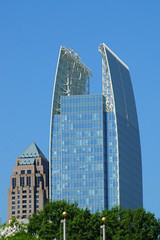Although it is still loosely defined, net-zero usually means a building that produces as much energy as is consumed
A few years ago in central Florida, John Santarpia had an idea. He was the president and CEO of a credit union and felt he needed to do something to improve its image.
“We’re a medium-sized credit union and there’s a lot of competition,” Santarpia said. “We wanted to stand out.”
He and his colleagues had found a lot in Lakeland, a city of about 100,000 residents, with an ice cream shop on it. Knowing the community wouldn’t be in favor of losing the ice cream shop, Santarpia decided to build a flagship building for his credit union around it. Whatever it was, he wanted to make it green. What resulted was the state’s first commercial net-zero-energy building.
“Financial institutions oftentimes are hesitant to try something new,” said Tim Hoeft, a sustainable designer at Straughn Trout Architects, which designed the building.
The difference is that Santarpia was interested in new technology and was attracted by the fact that there were no net-zero commercial buildings in Florida yet, Hoeft said. Santarpia wanted his to be the first.
Although it is still loosely defined, net-zero usually means a building that produces as much energy as is consumed. The Department of Energy’s website lists eight net-zero-energy commercial buildings up and running in the country. Most are small and in mild-weather environments. But the DOE number could be misleading because it relies on owners to voluntarily submit their building’s information. At the New Buildings Institute, Technical Director Mark Frankel estimates the real number could be closer to 25, with about 50 more in construction.
Santarpia’s building is among those not listed by the DOE. Through the construction and rebranding process, the credit union’s name changed from Community First to Magnify, in part to reflect a new, green identity. The decision to make the building net-zero evolved on its own. First, Santarpia and his colleagues looked into certifying the building under the U.S. Green Building Council’s Leadership in Energy and Environmental Design program. Once they figured out how to do that, they looked into putting solar panels on the roof.
“Then we asked, ‘How many solar panels would it take to go net-zero?'” he said.
During construction, Santarpia sought help from local design and construction professionals as well as the local utility company. They ended up with a rectangular-shaped building with just over 4,000 square feet of space, high ceilings and an upward-sloping roof. It opened in August 2009.
Related articles
- Building a Small Energy Efficient House (homebuildingsmart.com)
- Putting Energy-Hog Buildings on a Strict Diet (dailyfinance.com)
- Low and Zero Energy Buildings (ZEB) (pollutionfree.wordpress.com)









